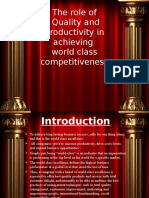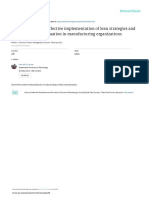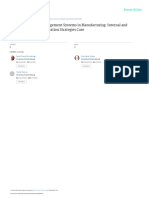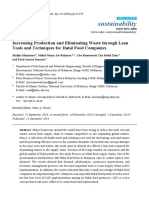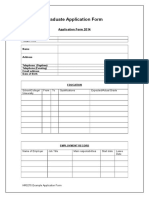Lean
Lean
Uploaded by
Jeffery MillefioreCopyright:
Available Formats
Lean
Lean
Uploaded by
Jeffery MillefioreCopyright
Available Formats
Share this document
Did you find this document useful?
Is this content inappropriate?
Copyright:
Available Formats
Lean
Lean
Uploaded by
Jeffery MillefioreCopyright:
Available Formats
Lean
Lean practices are defined processes that maximise customer value while minimising waste (Endsley
et al., 2006; Koning et al., 2006)
The lean practice ultimate goal is to achieve organisational efficiency and greater productivity while
providing quality services at lower cost (Koning et al., 2006; Shook, 2009; Smart et al., 2003)
Lean principles that reduce waste include: specifying customer value, identifying value streams,
creating flow processes, highlighting demand and prioritising problem resolution (Waring and
Bishop, 2010; Yang et al., 2011; Staats et al., 2011).
Lean practices involve Plan-Do-CheckAdjust (PDCA) cycles (Baker et al., 2009; Liker and Franz, 2011)
Wadhwa (2002) states that influencing patient perception is increasingly recognised in healthcare
systems. Patient perception is positively linked to their healthcare quality perceptions. She also
stresses that when patient perceptions are positive, their clinical experience and outcomes are more
likely to be positive.
Intense global competition, rapid technological changes, advances in manufacturing and information
technology and discerning customers are forcing manufacturers to optimize manufacturing process,
operations, and all the possible nodes of supply chains that enable them to deliver high-quality
products in a short period of time.
designed to eliminate waste in every area extending from production to customer relations, product
design, supplier networks and factory management
incorporate less human effort, less inventory, less time to develop products, and less space to
become highly responsive to customer demand while producing top quality products in the most
efcient and economic manner possible
Manufacturers can use different lean tools and lean principles to reduce wastes and non-value
added (NVA) activities
reduce waste anywhere in the company, optimize core resources and establish a corporate culture
dedicated to identifying and continuously fostering customer satisfaction
They usedvaluestreammapping(VSM)asleansupplychaintooltoreducecostandleadtime and enhance
quality through P-D-C-A improvement cycle
Various lean adaptive methods (just-in-time According to the fourth principle of lean, production
process should be arranged like a pull system where the wastes are eliminated from the process and
the ow of the product is smooth
Increasing global competitiveness worldwide has forced manufacturing organizations to produce
high-quality products at a faster rate and at a competitive cost.
Azharul Karim Kazi Arif-Uz-Zaman, (2013),"A methodology for effective implementation of lean
strategies and its performance evaluation in manufacturing organizations", Business Process
Management Journal, Vol. 19 Iss 1 pp. 169 196
Lean manufacturing is one of the most widely accepted performance
Lean implementation can lead to improvement in
flexibility,wasteelimination,optimization,processcontrolandpeopleutilization
5S: The 5S program focuses on systematically achieving total organization, visual order, cleanliness
and standardization. A well-organized workplace results in a safer and more productive operation.
The experts believe that 5S advocates eliminating delays by maintaining good housekeeping facility,
as it helpsinchoosingtherighttoolwithoutdelay
ThepurposeofERPistofacilitatetheflow of information between all business functions inside the
boundaries of the organizationandmanagetheconnectionstooutsidestakeholders.ERPsystems
automate and integrate internal and external management information across
anentireorganizationincludingfinance/accounting,manufacturing,salesand
serviceandcustomerrelationshipmanagement.
Undersuchconditions,eliminatingallkindsofwastesassumeshigh
significance,makingLeanimplementationanaturalchoiceforthemanufacturingsectofrom
Vikram Sharma Amit Rai Dixit Mohd. Asim Qadri , (2016),"Modeling Lean implementation for
manufacturing sector", Journal of Modelling in Management, Vol. 11 Iss 2 pp. 405 - 426
improvementstrategiesworldwide
Ithelpsinrepresentingvisuallywhatisgoingon
inthevaluestreamtoimprovetheflowofmaterialandinformationinthevalue chain by eliminating over-
production, unnecessary inventory or any other non-value-adding activity (Devadasan et al., 2012).
ThegoaloftheLeanmanufacturingsystemis doing more with less time, space, human effort while
giving the customer what they wantinahighlyeconomicalmanner(Paranitharanetal.,2011
You might also like
- Small Arms of The World - A Basic Manual of Small ArmsDocument774 pagesSmall Arms of The World - A Basic Manual of Small ArmsAndrea Grazioli100% (8)
- Continuous Improvement Trio (TOC, Lean and Six Sigma)Document3 pagesContinuous Improvement Trio (TOC, Lean and Six Sigma)Estrategia FocalizadaNo ratings yet
- Cculture and Organisations (Hr0372) : W16040809 BaslcmDocument13 pagesCculture and Organisations (Hr0372) : W16040809 BaslcmJeffery Millefiore100% (5)
- DraftDocument8 pagesDraftJeffery MillefioreNo ratings yet
- Case Study Chapter 1Document4 pagesCase Study Chapter 1Đặng Linh100% (2)
- World class manufacturingDocument15 pagesWorld class manufacturingOmprakashNo ratings yet
- 05achieving Operational Excellence in Production Process PDFDocument21 pages05achieving Operational Excellence in Production Process PDFSudeshna BiswasNo ratings yet
- 015-0788 Organizational Culture by Change Management: DHL Global Forwarding Case StudyDocument27 pages015-0788 Organizational Culture by Change Management: DHL Global Forwarding Case Studynyan hein aungNo ratings yet
- Contemporary Management Philosophies and ToolsDocument11 pagesContemporary Management Philosophies and ToolsYula ParkNo ratings yet
- Lean Manufacturing Literature Review PDFDocument13 pagesLean Manufacturing Literature Review PDFwzsatbcnd100% (1)
- Tran Phuc Huy Co1 124 Pom A2Document30 pagesTran Phuc Huy Co1 124 Pom A2Linh Hong PhamNo ratings yet
- Lean Manufacturing Literature Review and Research IssuesDocument5 pagesLean Manufacturing Literature Review and Research IssueseyewhyvkgNo ratings yet
- Ermer and Kniper (1998)Document1 pageErmer and Kniper (1998)mahesa parameswaraNo ratings yet
- Ijaiem 2013 06 14 043Document7 pagesIjaiem 2013 06 14 043editorijaiemNo ratings yet
- I - Introduction Total Quality Management (TQM) Is A Comprehensive Management Approach That Originated inDocument6 pagesI - Introduction Total Quality Management (TQM) Is A Comprehensive Management Approach That Originated inJennelyn Saupi BantalaNo ratings yet
- Factors, Measures, and Problems of Quality Costs Program Implementation in The Manufacturing EnvironmentDocument6 pagesFactors, Measures, and Problems of Quality Costs Program Implementation in The Manufacturing EnvironmentFahad IzharNo ratings yet
- The Internal Lean Dimensions Impact On The Manufacturing Based Product Quality of Food Processing Companies in JordanDocument14 pagesThe Internal Lean Dimensions Impact On The Manufacturing Based Product Quality of Food Processing Companies in JordanJaved IqbalNo ratings yet
- Six Sigma in Service OrganisationsDocument18 pagesSix Sigma in Service OrganisationsJosh PintoNo ratings yet
- Implementation of The Lean Six Sigma Framework in Non-Profit Organisations A Case StudyDocument18 pagesImplementation of The Lean Six Sigma Framework in Non-Profit Organisations A Case StudyYolandaNo ratings yet
- Implementation of The Quality Management System (ISO 9001: 2015) in The Bodywork IndustryDocument10 pagesImplementation of The Quality Management System (ISO 9001: 2015) in The Bodywork IndustryAmine ABASSINo ratings yet
- Impact of Information Systems Capabilities and Total Quality Management On The Cost of QualityDocument11 pagesImpact of Information Systems Capabilities and Total Quality Management On The Cost of QualityAleksandra RandjelovicNo ratings yet
- The Role of Quality and Productivity in Achieving World Class CompetitivenessDocument16 pagesThe Role of Quality and Productivity in Achieving World Class CompetitivenessNeeraj JainNo ratings yet
- Application of Six Sigma in Supply Chain Management: Evaluation and Measurement ApproachDocument19 pagesApplication of Six Sigma in Supply Chain Management: Evaluation and Measurement ApproachmadhpanNo ratings yet
- Importance of TQMDocument4 pagesImportance of TQMAnkush SinghNo ratings yet
- A Sustainable Continuous Improvement Methodology at An Aerospace Company OKDocument19 pagesA Sustainable Continuous Improvement Methodology at An Aerospace Company OKchrysobergi100% (1)
- Helping Science To Succeed: Improving Processes in R&DDocument7 pagesHelping Science To Succeed: Improving Processes in R&DTom TompsonNo ratings yet
- Lean Production Literature ReviewDocument8 pagesLean Production Literature Reviewafdtwtdsa100% (1)
- Operational Excellence: PhilosophyDocument10 pagesOperational Excellence: PhilosophySurjeet KumarNo ratings yet
- TQM in Corporate Hospitals - Using Six SigmaDocument15 pagesTQM in Corporate Hospitals - Using Six SigmaApollo Institute of Hospital Administration100% (3)
- Blending The Best of Lean Production and Six SigmaDocument12 pagesBlending The Best of Lean Production and Six SigmaMansoor AliNo ratings yet
- The Effect of Lean Operations in ManufacDocument7 pagesThe Effect of Lean Operations in ManufacEnoch TwumasiNo ratings yet
- Emma WorkDocument7 pagesEmma Workoluwasegunnathaniel0No ratings yet
- Lean Six SigmaDocument8 pagesLean Six Sigma_srobert_No ratings yet
- Jurnal UtamaDocument11 pagesJurnal UtamaiymhaNo ratings yet
- BUMADocument11 pagesBUMAElaine Ü LubianoNo ratings yet
- Quality Function Deployment in Continuous Improvement: Elizabeth A. Cudney and Cassandra C. ElrodDocument35 pagesQuality Function Deployment in Continuous Improvement: Elizabeth A. Cudney and Cassandra C. Elrodzeeshanshani1118No ratings yet
- 1718-Article Text-6955-2-10-20220727Document27 pages1718-Article Text-6955-2-10-20220727vknsvrnNo ratings yet
- TQMDocument6 pagesTQMHamza Dawid HamidNo ratings yet
- Chapter 7Document3 pagesChapter 7Cathy MamigoNo ratings yet
- Shewhart Cycle: SpecificationDocument5 pagesShewhart Cycle: SpecificationManasa Reddy BillaNo ratings yet
- Al Araidah2010Document8 pagesAl Araidah2010jf.leungyanNo ratings yet
- Hidden Costs of QualityDocument13 pagesHidden Costs of QualityWilliam ScottNo ratings yet
- FP Last SemDocument173 pagesFP Last SemAthira RaveendranNo ratings yet
- A Methodology For Effective Implementation of Lean Strategies and Its Performance Evaluation in Manufacturing OrganizationsDocument29 pagesA Methodology For Effective Implementation of Lean Strategies and Its Performance Evaluation in Manufacturing OrganizationsMohammed SirelkhatimNo ratings yet
- Bel 8 2 2024 7Document15 pagesBel 8 2 2024 7chchenineNo ratings yet
- 615-OptimizingQualityManagementSystemsinManufacturing (1)Document12 pages615-OptimizingQualityManagementSystemsinManufacturing (1)Marija StanojeskaNo ratings yet
- Theory Driven Real Time EmpiricalDocument12 pagesTheory Driven Real Time EmpiricalMaria MirandaNo ratings yet
- Quality Management Tools: Cause-And-Effect DiagramDocument4 pagesQuality Management Tools: Cause-And-Effect DiagramDevi PriyaNo ratings yet
- Methods of Research - Term PaperDocument6 pagesMethods of Research - Term PaperOLAOLUWANLESI ADANLAWO ELISHANo ratings yet
- A Case of Eliminating Wastes Using 5S For A Household Electrical Appliance WarehouseDocument10 pagesA Case of Eliminating Wastes Using 5S For A Household Electrical Appliance WarehouseShashwat ShrivastavaNo ratings yet
- TQM Implementation Concepts and Tools by Fred FeningDocument12 pagesTQM Implementation Concepts and Tools by Fred FeningRandy Domingo FanerNo ratings yet
- Lean Management in IKEADocument14 pagesLean Management in IKEAsalmarefaieNo ratings yet
- Tutorial-11-3 P&MQ Course WorkDocument10 pagesTutorial-11-3 P&MQ Course WorkrambasivaprasanthNo ratings yet
- A Framework For Lean Manufacturing ImplementationDocument10 pagesA Framework For Lean Manufacturing ImplementationAngelica LeonorNo ratings yet
- The Institution of Engineers (India) : Vijayawada Local CenterDocument8 pagesThe Institution of Engineers (India) : Vijayawada Local CentervenkateshmukharjiNo ratings yet
- Evaluating World Class Performance MeasurementDocument5 pagesEvaluating World Class Performance Measurementpsp710No ratings yet
- Literature Review Lean ManufacturingDocument5 pagesLiterature Review Lean Manufacturingc5praq5p100% (1)
- World Class ManufacturingDocument10 pagesWorld Class ManufacturingFatimah KhanNo ratings yet
- FOSTERING THE LEAN APPROACH AS A SUSTAINABLE STRATEGY CHALLENGES FROM PORTUGUESE COMPANIESInternational Journal For QualDocument12 pagesFOSTERING THE LEAN APPROACH AS A SUSTAINABLE STRATEGY CHALLENGES FROM PORTUGUESE COMPANIESInternational Journal For QualLucia QuispeNo ratings yet
- Six Sigma in Healthcare DeliveryDocument21 pagesSix Sigma in Healthcare Deliverymaribel100% (1)
- A Time Based Quantitative Approach For Selecting Lean Strategies For Manufacturing OrganisationsDocument23 pagesA Time Based Quantitative Approach For Selecting Lean Strategies For Manufacturing OrganisationsvikkiswarnakarNo ratings yet
- Sustainability 06 09179Document26 pagesSustainability 06 09179johnSianturiNo ratings yet
- International Journal of Production Research: Click For UpdatesDocument15 pagesInternational Journal of Production Research: Click For UpdatesAnonymous JqN1XeLhNo ratings yet
- Evolving Management Practices: Navigating the Modern Business LandscapeFrom EverandEvolving Management Practices: Navigating the Modern Business LandscapeNo ratings yet
- Int. J. Production Economics: Xingxing Zu, Tina L. Robbins, Lawrence D. FredendallDocument21 pagesInt. J. Production Economics: Xingxing Zu, Tina L. Robbins, Lawrence D. FredendallJeffery MillefioreNo ratings yet
- Logistics Individual AssignmentDocument5 pagesLogistics Individual AssignmentJeffery MillefioreNo ratings yet
- Highest Level of Education: (Circle Where Relevant) : HSSC Diploma Bachelor Masters PHDDocument5 pagesHighest Level of Education: (Circle Where Relevant) : HSSC Diploma Bachelor Masters PHDJeffery MillefioreNo ratings yet
- Sample - Ethical EssayDocument5 pagesSample - Ethical EssayJeffery MillefioreNo ratings yet
- Int. J. Production Economics: Xingxing Zu, Tina L. Robbins, Lawrence D. FredendallDocument3 pagesInt. J. Production Economics: Xingxing Zu, Tina L. Robbins, Lawrence D. FredendallJeffery MillefioreNo ratings yet
- VRIN Resources AnalysisDocument1 pageVRIN Resources AnalysisJeffery MillefioreNo ratings yet
- Sample - Ethical EssayDocument5 pagesSample - Ethical EssayJeffery MillefioreNo ratings yet
- Part 2 - Shangri-LaDocument3 pagesPart 2 - Shangri-LaJeffery Millefiore0% (1)
- What Are The Roles of Great Power inDocument10 pagesWhat Are The Roles of Great Power inJeffery MillefioreNo ratings yet
- What Are The Roles of Great Power inDocument10 pagesWhat Are The Roles of Great Power inJeffery MillefioreNo ratings yet
- Bonnet Dovell, (2016) - " Making Password Secure: Fixing The Weakest Link in Cybersecurity"Document1 pageBonnet Dovell, (2016) - " Making Password Secure: Fixing The Weakest Link in Cybersecurity"Jeffery MillefioreNo ratings yet
- Global & International Business Context (Sm0269) : Tan Hui KiatDocument8 pagesGlobal & International Business Context (Sm0269) : Tan Hui KiatJeffery MillefioreNo ratings yet
- Porter Diamond FinalDocument9 pagesPorter Diamond FinalJeffery MillefioreNo ratings yet
- Where Did The Empire GoDocument24 pagesWhere Did The Empire GoJeffery MillefioreNo ratings yet
- Graduate Application FormDocument3 pagesGraduate Application FormJeffery MillefioreNo ratings yet
- Iso 8573-5-2001Document6 pagesIso 8573-5-2001Tiago Luiz TortellaNo ratings yet
- Tabel 2.1 Tabel Plastik: JIS Testing MethodDocument3 pagesTabel 2.1 Tabel Plastik: JIS Testing MethodhanifNo ratings yet
- 23 Encoding PDFDocument5 pages23 Encoding PDFBharghav RoyNo ratings yet
- Bomba Neumatica Milton RoyDocument8 pagesBomba Neumatica Milton RoyGuillermo de la Fuente SantiagoNo ratings yet
- Oil Less Air Compressor Dental Suction UnitDocument6 pagesOil Less Air Compressor Dental Suction UnitchimedbatorNo ratings yet
- Motor Starter Components Finder - LC1D115M7Document7 pagesMotor Starter Components Finder - LC1D115M7worldnetlinkNo ratings yet
- PolyethyleneDocument3 pagesPolyethyleneEmily BrookNo ratings yet
- Feature Story FixedDocument5 pagesFeature Story Fixedapi-313350571No ratings yet
- Caa Safety Sense Leaflet - For VFRDocument8 pagesCaa Safety Sense Leaflet - For VFRWill HardyNo ratings yet
- BER Performance Analysis of Open and Closed Loop Power Control in LTEDocument12 pagesBER Performance Analysis of Open and Closed Loop Power Control in LTEossridNo ratings yet
- Corey ChandlerDocument2 pagesCorey ChandleryerocNo ratings yet
- Peri Domino 300 PDFDocument36 pagesPeri Domino 300 PDFThanos TsirkosNo ratings yet
- Saqi TPN 2Document15 pagesSaqi TPN 2saba ishtiaqNo ratings yet
- Electronics Today International April 1991Document68 pagesElectronics Today International April 1991waynefishing100% (1)
- 22-Caliber Revolver PDFDocument24 pages22-Caliber Revolver PDFApril Bishop100% (5)
- Komatsu Engine 6d170 1 Workshop Manuals 1Document20 pagesKomatsu Engine 6d170 1 Workshop Manuals 1dane100% (66)
- 009.1 2006 Abstracts MCR VII Volume 1 PiterDocument469 pages009.1 2006 Abstracts MCR VII Volume 1 PiterChau MaiNo ratings yet
- Data Sheet FAG 50Z 11.14 4.5 DM CouplingDocument1 pageData Sheet FAG 50Z 11.14 4.5 DM Couplingadamnassir91No ratings yet
- Xerox Workcentre 5945/5955 Multifunction Printer: Quick Start GuideDocument71 pagesXerox Workcentre 5945/5955 Multifunction Printer: Quick Start GuideLaura PescărușNo ratings yet
- Numatics Series l1 Solenoid CatalogDocument12 pagesNumatics Series l1 Solenoid CatalogLeninNo ratings yet
- External Interrupt Stepper Motor PDFDocument5 pagesExternal Interrupt Stepper Motor PDFJashwanth saiNo ratings yet
- Daslight DVC2 512 Virtual Controller Usermanual PDFDocument45 pagesDaslight DVC2 512 Virtual Controller Usermanual PDFViktoria NovikovaNo ratings yet
- Experiment E1.07 Differential AmplifierDocument16 pagesExperiment E1.07 Differential AmplifierMohd FuadNo ratings yet
- Structural Analysis For US-APWR RCPM FlywheelDocument19 pagesStructural Analysis For US-APWR RCPM FlywheelChris StroudNo ratings yet
- Classroom Management Strategies of Multigrade Schools With Emphasis On The Role of TechnologyDocument10 pagesClassroom Management Strategies of Multigrade Schools With Emphasis On The Role of TechnologySally Consumo KongNo ratings yet
- 3Document8 pages3SHREYAS MSNo ratings yet
- Reactors1 27Document2 pagesReactors1 27Mourad kharbachNo ratings yet
- User Manual: Leon Super Cup MK 2Document92 pagesUser Manual: Leon Super Cup MK 2Adrian SbarceaNo ratings yet





















